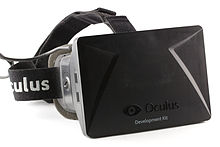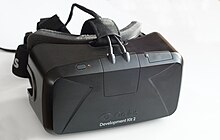Oculus Rift
It was the first virtual reality headset to provide a realistic experience at an accessible price, utilizing novel technology to increase quality and reduce cost by orders of magnitude compared to earlier systems.
The first prototype of the Oculus Rift was created in 2011 by Palmer Luckey (then 18 years old) in his parents’ garage in Long Beach, California.
[8] Luckey had been building his own virtual reality headsets since 2009, but the 2011 prototype was the first to incorporate key technologies like geometric pre-distortion and a wide stereoscopic field-of-view that would come to define all of his subsequent designs.
[1] Luckey decided to drop out of college and start Oculus VR, intending to turn his prototype into the world's first mass-produced virtual reality headset.
Noted videogame pioneer John Carmack, the founder of id Software, had been doing extensive research into virtual reality technology, leading Luckey to lend him a prototype Oculus Rift.
Carmack wrote a public review of the prototype calling it "by far the most immersive HMD" he had used, noting that the targeted price would also make it the cheapest.
[12][13]Two months after being formed as a company, Palmer's Oculus VR launched a Kickstarter crowdfunding campaign on August 1, 2012, for their virtual reality headset, named the Rift.
[16][17] The Rift DK1 was released on March 29, 2013,[18] and uses a 7-inch (18 cm) screen with a significantly faster pixel switching speed than the original prototype, reducing latency and motion blur when turning one's head quickly.
It uses a combination of three-axis gyros, accelerometers, and magnetometers, which make it capable of absolute (relative to Earth) head orientation tracking without drift.
This step forwards to twice the number of pixels as DK1 significantly reduced the screen door effect and made objects in the virtual world more clear, especially at a distance.
[23] This is a small refinement of the "Crystal Cove" prototype, featuring several key improvements over the first development kit, such as having a higher-resolution (960×1080 per eye) low-persistence OLED display, higher refresh rate of 75 Hz,[24] positional tracking, a detachable cable, and the omission of the need for the external control box.
A teardown of DK2 revealed that it incorporates a modified Samsung Galaxy Note 3 smartphone display, including the front panel from the device itself.
[27] During a panel at SXSW 2015, titled "Explore the Future of VR", it was publicly announced for the first time that the prototype uses two screens instead of one as previously thought.
[40] The runtime service implements a number of processing techniques intended to minimize latency and in addition improve the smoothness of VR applications under weaker hardware.
[42] An update to the base software, called Core 2.0, introduced a more interactive default environment, allowing the user to navigate and customize it with imported 3D models.
Most listings are also rated on their comfort level based on their likelihood of causing motion sickness or number of jump scares.
[46] This is a feature complete SDK which handles for the developer the various aspects of making virtual reality content, such as the optical distortion and advanced rendering techniques.
[65][66] In July 2015, Oculus revealed that it was fully funding more than 20 second party high production value games made exclusively for the Rift, one of these being Insomniac's Edge of Nowhere.
[71] In July 2015, Oculus announced a deal with Canadian film company Felix & Paul Studios to produce 360° 3D videos for the Rift.
Oculus Story Studio showed off its first VR movie, Lost, at the 2015 Sundance Film Festival, gaining positive reviews from attendees.
[73][74][75] The studio intends to have 5 VR shorts released with the Rift at launch, including Lost, Bullfighter, Henry, Dear Angelica, and Kabloom.
[77] As well as the consumer uses, the Rift has attracted significant interest from industry and professional spheres for productivity enhancement, visualization, and advertising.
[83][84] The Norwegian Army has been experimenting with the Rift Development Kit 2 to allow for a greater situational awareness of armoured vehicle drivers and commanders.
In particular, there appears to be benefits to medical, health science and exercise students when utilising the Oculus Rift as a supplement for content provided in anatomy and physiology.
[citation needed] Fox Sports began producing content for the Oculus Rift and other virtual reality systems in fall 2016.
The jury ruled partially in favor of ZeniMax, finding the defendants did not steal trade secrets but had violated a non-disclosure agreement.
The Verge felt that the Rift was a "remarkably well-made and accessible device", describing its hardware design as having succeeded in "mak[ing] something so stereotypically geeky look (relatively) natural", and the headset itself as being "lighter and more comfortable than most of its competition" once properly fitted to the user's head.
However, the reviewer felt that the Rift's launch titles marked the first time they had played any VR game that could "rival a decently made non-VR computer game for polish and scope", and the Vive and then-upcoming Oculus Touch controllers showed a bigger potential for VR than the largely stationary experiences the Rift offered at launch.
It was argued that, while acknowledging the cost limitations of the headset and the necessary computing hardware, and its "relentless" focus on gaming, the Oculus Rift "makes a good case for seated VR, and it lays a solid foundation for what's to come.
[96] In a post-launch review, PCMag felt that the Oculus Touch controllers, improved support for room-scale experiences, and a recent price cut to US$399 made the Rift "more appealing than the more expensive HTC Vive", concluding that it "produces an immersive, crisp virtual reality experience that will continue to improve with the development of new software, which has been steadily coming out on both the Oculus store and SteamVR.





